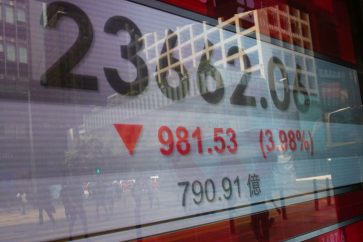Established in 1988, Algonquin Power & Utilities (TSX:AQN) has increased its assets to over US$18 billion. About 70% of its operations comprise regulated utilities, including electric, natural gas, water, and wastewater, spread over 16 jurisdictions. The remaining assets in its portfolio are hydropower, solar, and wind power.
Economic contraction weighing on AQN stock
The US accounts for over 75% of the utility’s income. Technically, the United States is already in a recession, which hurts stocks generally, including AQN stock. A recession is characterized by two quarters of falling gross domestic product (GDP). Notably, the GDP has decreased by 1.6% and 0.6% over the past two quarters, respectively, signaling a milder recession thus far.
The TSX stock has dropped more than 21% this year as of this writing. A chart of the price movement of the AQN stock is shown below.
The fact that the U.S. dollar is stronger than the Canadian dollar is already assisting this price movement. When writing, the AQN stock price’s year-to-date fall on the NYSE is greater than 27%.
Rising interest rates pressuring AQN
Central banks can raise short-term interest rates to reduce rising inflation. Additionally, this will slow economic expansion and deter venture capital funding. Utilities’ balance sheets are already heavily indebted. In comparison to the end of 2019, Algonquin had less than US$7.3 billion in long-term debt and a debt-to-equity ratio of 1.3 at the end of the second quarter. AQN stock is now a riskier investment than in the past due to the greater debt levels in an environment of rising interest rates.
AQN stock has a track record of paying solid dividends
The AQN stock has increased dividend payments for the eleventh year this year. Its 9.5% dividend growth rate over ten years is comparatively high in the utility sector. The dividend stock should continue to offer above-average growth because it is a relatively small utility. Its current yield, which is about 6.9%, is vital.
Here’s where AQN stock’s growth will come from
From 2022 to 2026, Algonquin has a capital plan worth $12.4 billion USD. Given that its stock price has decreased, it makes little sense for the stock to push out equity now. The financial markets are experiencing a capital shortage.
Management plans to raise around US$277 million and CA$107 million by selling partial shares in three wind farms. “AQN will continue to oversee daily operations and provide management services to the sites,” the press announcement added. Since management anticipates concluding this deal by the end of 2022, there is no need to issue any shares.
Furthermore, Algonquin is purchasing Kentucky Power for $2.65 billion, which is $200 million less than the previous enterprise value. Nearly 80% of AQN’s business will now be made up of regulated electric utilities thanks to Kentucky Power, which should boost the stability of AQN’s financial performance. The U.S. Federal Energy Regulatory Commission must yet approve this transaction. If everything goes according to plan, the deal should be finished in January.
Analysts are bullish on AQN stock
In the long run, the depressed stock trades at a favorable valuation. As a result, most analysts are optimistic about the AQN stock. The US$15 12-month analyst consensus price objective indicates a significant discount of over 30%. But given the state of the market right now, stocks will typically be down. Investors shouldn’t, therefore, anticipate a quick change in the stock.
The Foolish investor takeaway
The macro-environment, which includes a slowing economy and rising interest rates, is mostly to blame for the drop in the price of AQN shares. Not just the AQN stock but all stocks have been under pressure from this economic climate. The utility company consistently grows its dividend, and its current yield is incredibly alluring. It also has a multi-year capital strategy to provide growth that is above normal. Consider developing a stake for long-term investment if you’re an interested investor.
Read More:



 By:
By:





